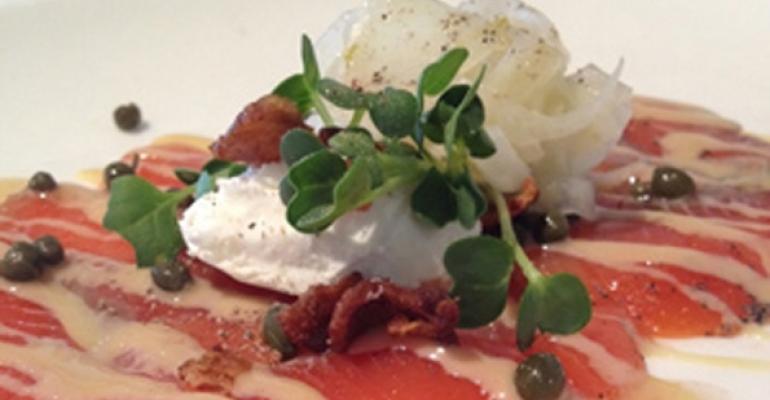RELATED
• Restaurants welcome fall with seafood steampots
• New York chef serves up unusual seafood
• More restaurant industry seafood trends
Adam Brown has renewed his focus on seafood since last month, when he was named executive chef of Skates on the Bay, a waterfront restaurant in Berkeley, Calif., owned by Seattle-based Restaurants Unlimited.
Although the restaurant has some “land dishes,” such as beef and chicken, Brown said they’re on the menu for the same reason steak houses have vegetarian options — just to make sure that there’s something for everyone. But he said upwards of 85 percent of the food at the restaurant is seafood.
 That’s a change from much of his career. Although most recently Brown was corporate executive chef of Beets Hospitality Group of Livermore, Calif., which operates two noncommercial operations, Brown spent many years in the chain restaurant world as corporate chef at Bubba Gump’s Shrimp Company, as executive chef and partner of the P.F. Chang’s location in his hometown of Pleasanton, Calif., and as chef of the Ruth’s Chris Steakhouse in Walnut Creek, Calif.
That’s a change from much of his career. Although most recently Brown was corporate executive chef of Beets Hospitality Group of Livermore, Calif., which operates two noncommercial operations, Brown spent many years in the chain restaurant world as corporate chef at Bubba Gump’s Shrimp Company, as executive chef and partner of the P.F. Chang’s location in his hometown of Pleasanton, Calif., and as chef of the Ruth’s Chris Steakhouse in Walnut Creek, Calif.
Brown recently discussed sourcing and serving seafood in his new position at Skates on the Bay with Nation's Restaurant News.
Where does most of your seafood come from?
A lot of it comes from Alaska and Washington. Right now we have wild Alaska troll-caught king salmon, and Royal Miyagi oysters from Washington. We do get our Dungeness crab meat locally.
 Are Berkeley customers very inquisitive about where their seafood comes from?
Are Berkeley customers very inquisitive about where their seafood comes from?
Yes, so I educate the staff on a daily basis if where our seafood comes from changes. We also write on a chalkboard on our raw bar where everything comes from. We have to do that in Berkeley, but it’s also the philosophy of the company to be as seasonal and sustainable as we can be.
We have a very good relationship with my seafood company, and I have a daily conversation with my rep, and a weekly update on what trends are coming out. It allows me also to give our guests the freshest, most sought-after seafood possible.
 What do you expect to see this fall?
What do you expect to see this fall?
Our oysters are going to be fantastic — Royal Miyagis and Kumamotos coming from up in the Olympic Peninsula.
We’re also going to be getting fresh Coho salmon [from Alaska], since Sockeyes are done running. We’re still getting fresh Alaska kings, but we get ones that are troll-caught, not net caught.
Why do you prefer troll-caught kings?
They come in larger, and I like the fat content better.
What else are you seeing?
We’re getting u-10 scallops that we sear and serve with carrot purée, braised pork risotto and an arugula, fennel and pickled shallot salad. So it’s a dish that goes into that fall yet fresh seasonal neighborhood.
Why do you serve braised pork with scallops?
The pork is braised with the carrots, and onions, so you get some of that earthiness and a really nice sweetness that blends well with the scallops. It’s a really nice marriage of textures and flavors. We’ve gotten amazing feedback. The purée is smooth, you get crunch from fennel, acid from the shallots, pepper from the arugula. It’s really nice and fresh and has depth of flavor.
I’m looking at maybe bringing in some wild barramundi. I’m finding out if we can get enough of it. I don’t want a guest fall in love with it and then not be able to get it anymore.
I’m also looking at potentially bringing in sturgeon dish. I want to grill it and serve it with a savory bread pudding and mustard sabayon.
We’re also looking at if I can get some Corvina sea bass. That’s a long-line caught wild sea bass, so I’m seeing what kind of velocity I can get from my purveyors.
Contact Bret Thorn at [email protected].
Follow him on Twitter: @foodwriterdiary





